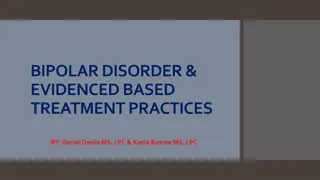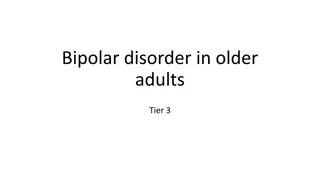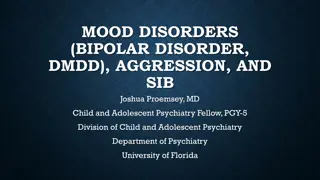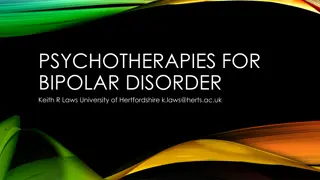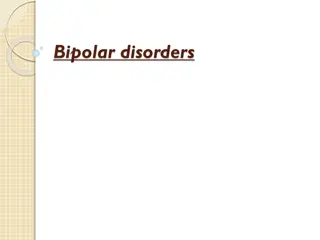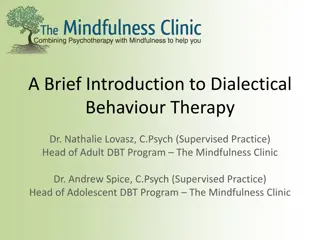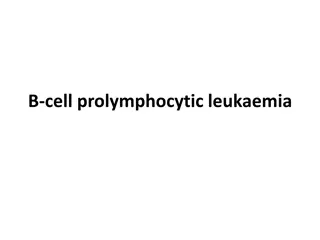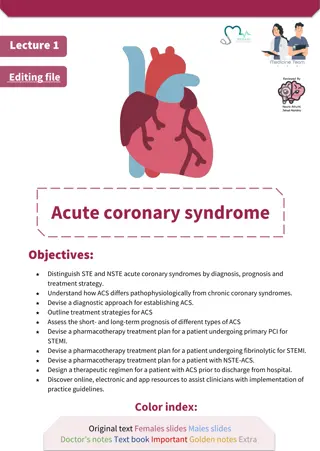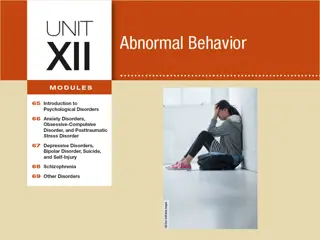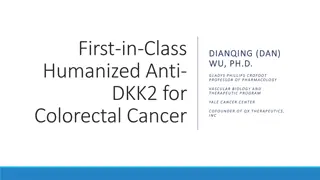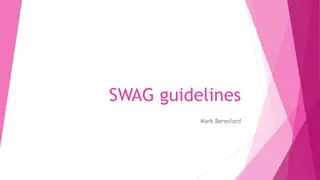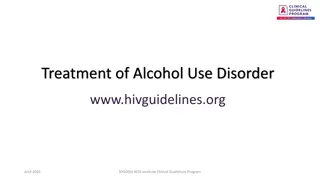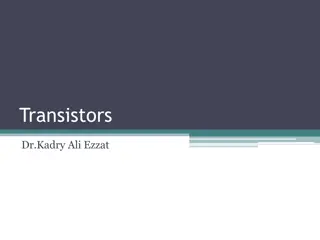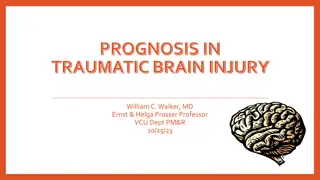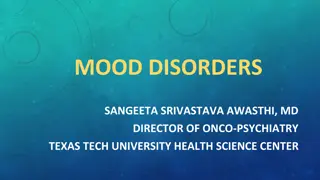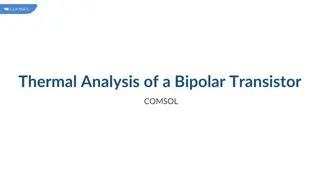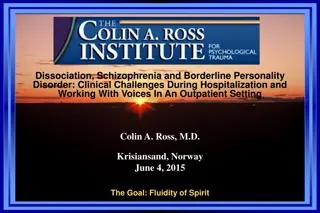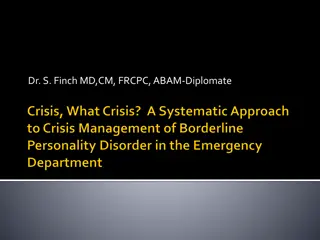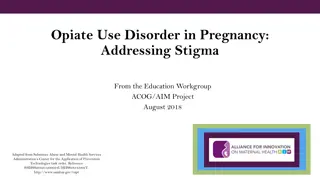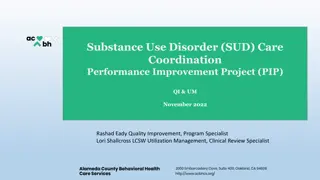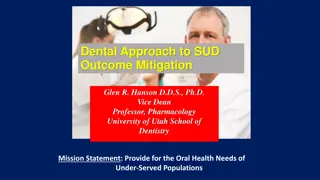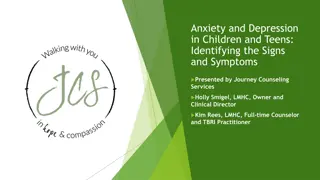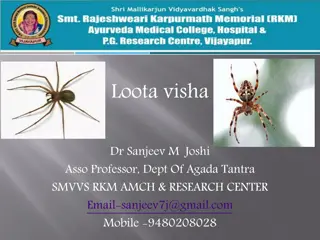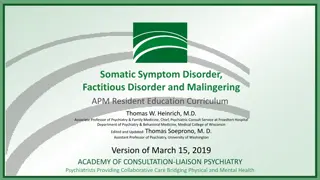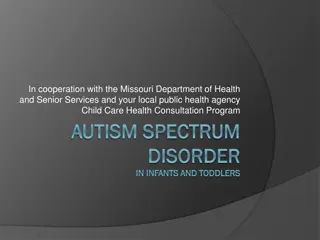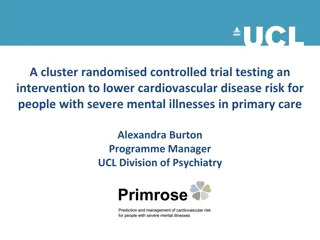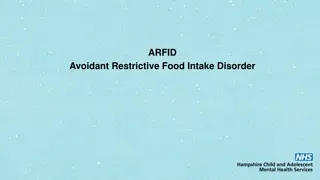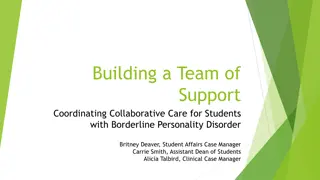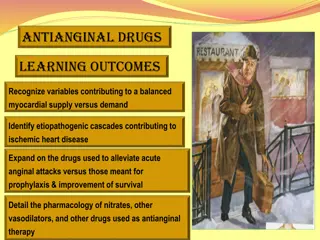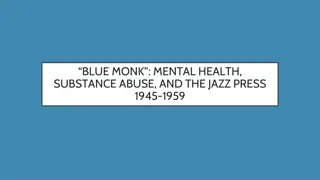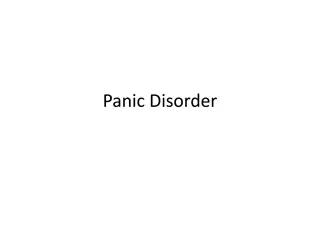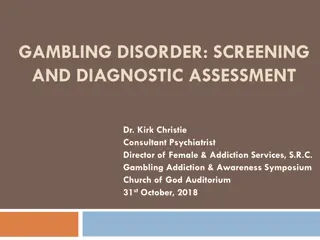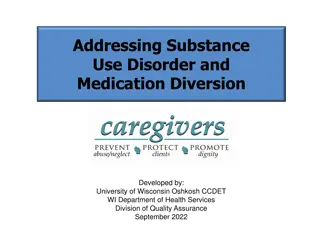Understanding Bipolar Disorder: Course, Prognosis, and Treatment
Develop a comprehensive understanding of Bipolar disorder, including its course, prognosis, and risk factors for poor outcomes. Explore the prevalence, time course, and intensity of the disorder, as well as different types and changes in presentation over time. Gain insights from expert-led sessions and delve into research articles for deeper study.
Download Presentation

Please find below an Image/Link to download the presentation.
The content on the website is provided AS IS for your information and personal use only. It may not be sold, licensed, or shared on other websites without obtaining consent from the author. Download presentation by click this link. If you encounter any issues during the download, it is possible that the publisher has removed the file from their server.
E N D
Presentation Transcript
MRCPsych General Adult Psychiatry Bipolar 4
Bipolar 4 Objectives To develop an understanding of: the course and prognosis of Bipolar disorder. risk factors for poor outcomes.
Bipolar 4 Expert Led Session Bipolar Affective Disorder: Course & Prognosis
This presentation is based on an APT article: Saunders KEA, Goodwin GM (2010). The course of bipolar disorder. Advances in Psychiatric Treatment. 16 (5) 318-328. The paper summarises dozens of articles which are referenced in the original for personal study.
What constitutes Bipolar? This effects how we think about course, treatment and prognosis Studies have generally only dealt with traditional Manic- Depression (Bipolar 1) There is less information about other types We must be clear which concept is meant when answering patients/in exam Prevalence is 1% (RCPsych using conventional concept)
Time course & intensity Patients generally have further episodes Only 16% have definitive recovery Relapsing/remitting pattern Length of episodes varies greatly Mania mean episode average - 6 weeks Depression - 11 weeks Mixed affective state - 17 weeks
Time Course & intensity x2 frequency over uni-polar Time between cycles shortens for first three, then stabilises Risk of suicide 1% annually (Baldessarini 2006) Polarity of onset may convey prognostic advantages: unipolar mania at presentation = best prognosis.
Types & changes in type 40% depressed on 1st presentation Switch to bipolar higher in the young 1% per year >30 y/o Conversion from Bipolar II just 7.5% in 10 years Course is similar but without full manic episodes (>4 days, etc) Rapid cycling (>4 episodes/yr) affects 12-24%
Treatment response Aim is to reduce frequency and intensity Complete remission is unlikely 30-50% respond to lithium/anticonvulsant when in the manic phase Similar rate with atypical antipsychotics 30% respond to lithium/anticonvulsant in depression 50% with lamotrigine >50% with quetiapine
Inter-episode symptoms Sub-syndromal 15% of the time and minor symptoms for a further 20% of the time Cognitive functioning can be deficient Reduced general quality of life
Physical comorbidities Poor glucose regulation more common Up to 35% obese Thyroid disorders 9% (even in lithium na ve) Migraine more common
Pregnancy Relapse generally said to be 50% 27% of women with bipolar admitted in 1st year post-partum Non-concordance increases relapse
Mortality SMR overall = 1.6 For suicide risk in bipolar SMR = 12.28 Medication reduces mortality Lithium shown to decrease suicide
Key Points Age at onset is late teens to twenties on average 40% of individuals are initially diagnosed with unipolar depression Bipolar I disorder remains a relatively rare, frequently psychotic disorder: significant inter-episode cognitive impairment may exist in the absence of an affective episode Bipolar II disorder is a stable diagnosis, now made more frequently and associated with a chronic course in which depression is usually the predominant polarity
Key Points 2 Bipolar-spectrum diagnoses reflect the prevalence of mild elated states but carry uncertain implications for treatment Long treatment delays are common (1/3 wait 10 years) Childbirth is associated with high rates of relapse
Bipolar 4 MCQs 1. Using the broadest definition, prevalence of bipolar spectrum disorders in the general population has been estimated as high as: A. B. C. D. E. 0.8% 1.2% 3.9% 8.3% 10.4%
Bipolar 4 MCQs 1. Using the broadest definition, prevalence of bipolar spectrum disorders in the general population has been estimated as high as: A. B. C. D. E. 0.8% 1.2% 3.9% 8.3% 10.4%
Bipolar 4 MCQs 2. Age at onset of bipolar disorder: A. Has little prognostic relevance B. Is not a heritable trait C. Has been observed to be higher in more recent studies D. Is higher in women than men E. Has implications for clinical course
Bipolar 4 MCQs 2. Age at onset of bipolar disorder: A. Has little prognostic relevance B. Is not a heritable trait C. Has been observed to be higher in more recent studies D. Is higher in women than men E. Has implications for clinical course
Bipolar 4 MCQs 3. Individuals with bipolar disorder: A. Rarely receive a diagnosis of unipolar depression B. Have longer episodes of mania than depression C. Commonly have psychiatric co-morbidities D. Have fewer depressive episodes than those with unipolar depression E. Show poorer prognosis if they have predominantly manic episodes
Bipolar 4 MCQs 3. Individuals with bipolar disorder: A. Rarely receive a diagnosis of unipolar depression B. Have longer episodes of mania than depression C. Commonly have psychiatric co-morbidities D. Have fewer depressive episodes than those with unipolar depression E. Show poorer prognosis if they have predominantly manic episodes
Bipolar 4 MCQs 4. When compared with bipolar I disorder, bipolar II disorder: A. Is associated with better inter-episode functioning B. Is similar and frequently develops into bipolar I disorder C. Is associated with fewer affective episodes overall D. Has a less chronic course E. Has a significantly higher age at onset
Bipolar 4 MCQs 4. When compared with bipolar I disorder, bipolar II disorder: A. Is associated with better inter-episode functioning B. Is similar and frequently develops into bipolar I disorder C. Is associated with fewer affective episodes overall D. Has a less chronic course E. Has a significantly higher age at onset
Bipolar 4 MCQs 5. Regarding the treatment of bipolar disorder: A. Delays in initiating treatment are rare B. The vast majority of patients respond to lithium or an anticonvulsant treatment when in a manic phase C. Quetiapine leads to remission in over 50% of patients in the depressive phase D. There are a number of well-tolerated treatments that are effective in all phases of the illness E. The majority of patients are maintained on monotherapies
Bipolar 4 MCQs 5. Regarding the treatment of bipolar disorder: A. Delays in initiating treatment are rare B. The vast majority of patients respond to lithium or an anticonvulsant treatment when in a manic phase C. Quetiapine leads to remission in over 50% of patients in the depressive phase D. There are a number of well-tolerated treatments that are effective in all phases of the illness E. The majority of patients are maintained on monotherapies
Any Questions? Thank you


